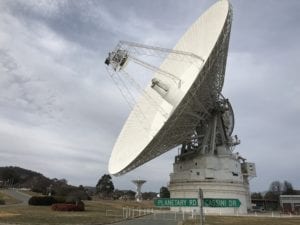By Nicholas Borroz

An underrecognized yet critical segment of the space sector is downlinking. Launch vehicles and satellites capture most of the headlines, but in and of themselves they have little value. They are a means to an end: they enable the flow of data that benefits people back here on Earth.
Put differently, downstream applications justify investing in and developing new launch vehicles and satellites. And those downstream applications depend on downlinking data from satellites. Any constraints on downlinking thus undermine the viability of launch and satellite businesses.
Yes, it is impressive to see reusable launch vehicles coming online. Yes, it is mindboggling to contemplate the scale of new satellite mega-constellations. But these developments do not matter if the data that satellites collect cannot be easily downlinked. Moreover, difficulties with downlinking may very well become more challenging as the number of satellites in orbit grow.
It’s hard to quantify how much of an issue downlink bandwidth issues are. How much does demand for downlinking services exceed supply? Qualitatively, though, it is nearly indisputable to say that downlink bandwidth constraints are a serious issue. In private conversation, many satellite owners and operators, as well as the users of the data collected by their satellites, will complain: it is difficult to get as much data as you want. Whether you are a small-time analytics firm or the operator of a satellite constellation, downlink constraints hamper business.
Imagine the following scenario. You have a firm that uses space-collected data to provide agricultural customers with analytical services to increase their profitability. Based on data collected in orbit, you tell customers when to add more fertilizer, when to increase irrigation, and when to use extra pesticides. Numerous satellites with appropriate sensors are already in orbit, and they are making regular passes over your area of interest. Great idea, right?
Not necessarily. Bandwidth constraints mean you only get small amounts of data, usually belatedly. Your services’ potential is being stymied by this trickle of data; what you need is a flow. Obviously, this undermines the profitability of your business model. Agricultural customers will not react kindly to being told they needed to use more pesticides two weeks ago. Good luck raising funding from venture capitalists if they are savvy to bandwidth problems.
Bandwidth constraints are seriously preventing the growth of the space sector. They constrain the possibilities of downstream analytics services, which in turn undermines the potential to make returns on investing in launch vehicles and satellite constellations. Bandwidth issues need more attention from people developing innovative tech to overcome them. Private financiers who are fueling New Space’s growth should also be aware of these issues and fund innovation.
For people interested in solving the issues (and potentially reaping profit along the way), read below for a succinct account of the problem and potential solutions to overcoming it.
In terms of the problem, the basic issue is that there is more demand than supply. There are a limited number of ground stations, all of which have particular strengths and weaknesses that affect demand for their downlinking services. On a global level, averaging out across these idiosyncrasies, there is not enough downlinking available. This means satellite firms must often wait; they must pass overground stations that are already busy downlinking for other customers. Particularly affected are low-tier customers; ground station operators are looking to make a buck, and they guarantee more daily passes to higher bidders. If you’re a low bidder then you get fewer passes. You downlink less data and you have to wait longer to get it.
In a nutshell, that’s the problem.
Now for the solutions. There are four big ones and they aren’t mutually exclusive.
The first is pretty obvious: build more ground stations. The more ground stations there are, the more data can be downlinked and the less time satellites will have to wait to downlink. One trend in the ground station business is to receive data in higher frequency bands, though, on the satellite end of things, this poses difficulties since more power is often required to boost the signal. A significant problem with building ground stations is that it’s capital-intensive. A lot of money is needed upfront before you reap rewards. And your demand projections might be off.
The second solution regards inter-satellite relay networks. Basically what this means is satellites can downlink without necessarily being overground stations. By creating constellations of satellites that can relay data between each other, it does not matter as much if any particular satellite is over any particular ground station. This tackles the latency issue head-on. There are different architectures of the relay networks – basically, how many satellites at what altitudes. The tradeoff is the higher up the satellites are, the fewer you need, but the higher the latency.
The third solution is onboard computing. This option allows satellites to intelligently process what data they collect and what data they downlink. They can choose to only collect data in swathes where there will likely be value (e.g. avoid collecting images where there’s cloud cover). Or they can delete data that is collected but which the onboard computing realizes is useless (e.g. delete the images with cloud cover). Onboard computing can also partially process data so that it is closer to a final product. All these options essentially allow the satellites to do more with less data; less downlinking is required, which indirectly overcomes bandwidth issues.
The fourth solution is optical communications, which are an alternative to radiofrequency communications – using lasers to “snipe” rather than RF to “shotgun” data. There are associated difficulties, including the atmosphere’s tendency to disrupt signals, the need for precise “pointing” for optical signals, and the unknown costs of developing ground station networks that specialize in optical downlinking. Optical communications seem to have particular potential when combined with inter-satellite relay networks; they could effectively shoot data throughout the network and then leave downlinking to more tried and true RF technologies.
That’s a brief account of the problem and the potential solutions. If you’re looking to make a splash in the space sector and also to make a dollar doing it, it may be worth your while to look into downlinking. It’s less sexy than rockets and constellations, sure, but developing downlinking solutions is necessary, obviously valuable, and potentially lucrative.

Nicholas Borroz manages Rotoiti, a consulting firms servicing customers in the space sector. He also runs Filling Space, a website that interviews space experts. He is completing his doctoral studies in international business at the University of Auckland.





